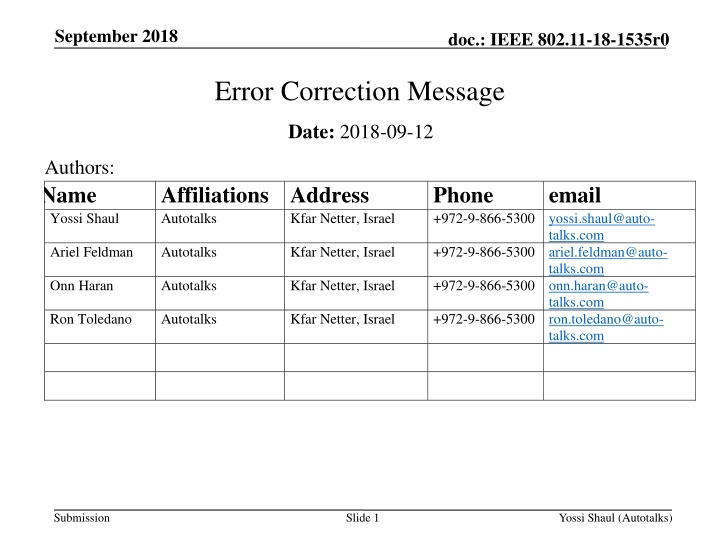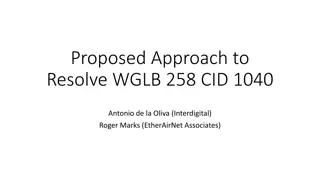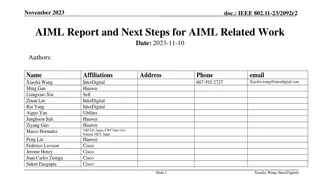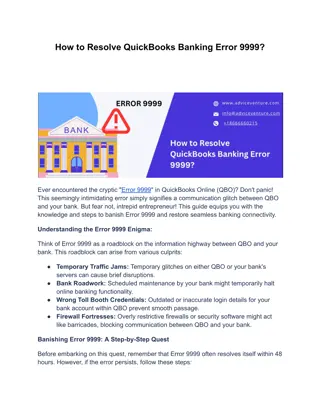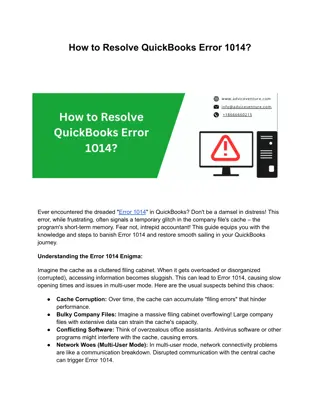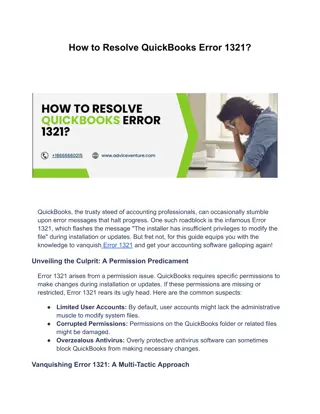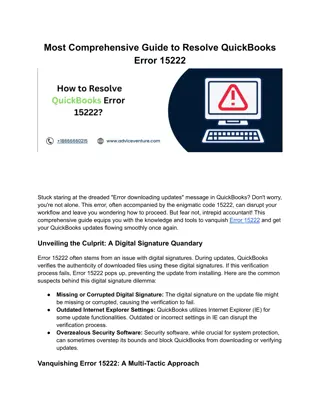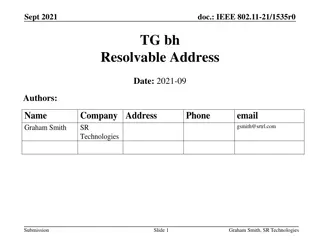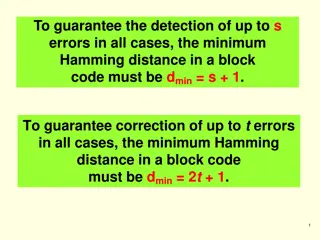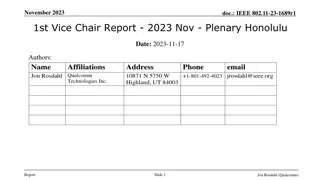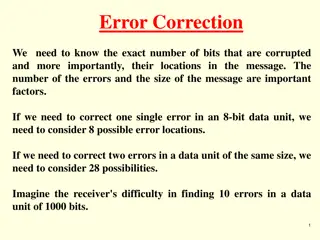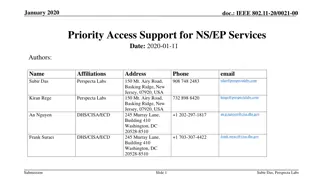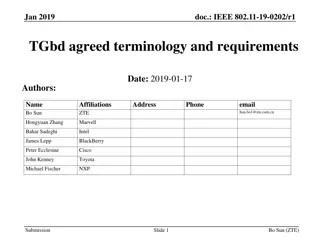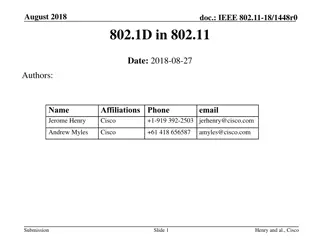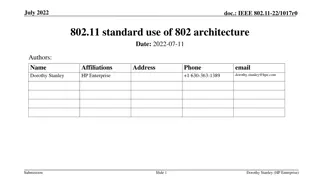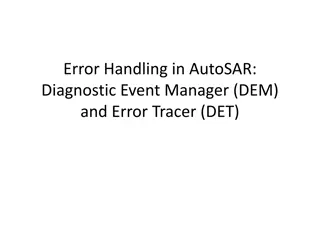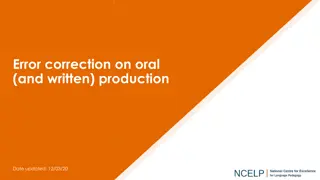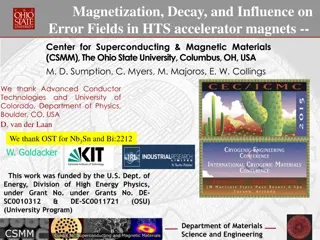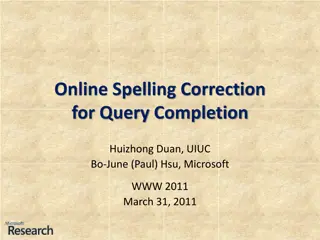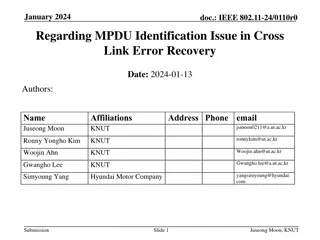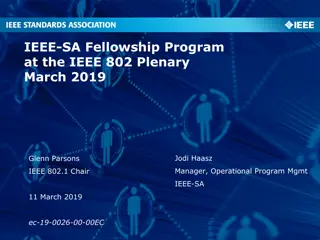IEEE 802.11-18-1535r0 Error Correction
This document discusses the concept of adding outer code for error correction in IEEE 802.11, including sending parity bytes post-packet and utilizing dedicated error correction packets. It covers topics such as byte-interleaved outer code, dedicated error correction packets, and outer code configuration for improved error detection and correction in wireless communication protocols.
Download Presentation

Please find below an Image/Link to download the presentation.
The content on the website is provided AS IS for your information and personal use only. It may not be sold, licensed, or shared on other websites without obtaining consent from the author.If you encounter any issues during the download, it is possible that the publisher has removed the file from their server.
You are allowed to download the files provided on this website for personal or commercial use, subject to the condition that they are used lawfully. All files are the property of their respective owners.
The content on the website is provided AS IS for your information and personal use only. It may not be sold, licensed, or shared on other websites without obtaining consent from the author.
E N D
Presentation Transcript
September 2018 doc.: IEEE 802.11-18-1535r0 Error Correction Message Date: 2018-09-12 Authors: Name Yossi Shaul Affiliations Address Autotalks Phone +972-9-866-5300 yossi.shaul@auto- email Kfar Netter, Israel talks.com Ariel Feldman Autotalks Kfar Netter, Israel +972-9-866-5300 ariel.feldman@auto- talks.com +972-9-866-5300 onn.haran@auto- talks.com +972-9-866-5300 ron.toledano@auto- talks.com Onn Haran Ron Toledano Autotalks Kfar Netter, Israel Autotalks Kfar Netter, Israel Submission Slide 1 Yossi Shaul (Autotalks)
September 2018 doc.: IEEE 802.11-18-1535r0 Background During the last meeting, the concept of adding outer code was presented IEEE802.11-18-1214 The suggestion was sending parity bytes of outer code post packet utilizing the large 10MHz DIFS Alternative scheme, using a dedicated packet to send the parity bytes of outer code, is presented Submission Slide 2 Yossi Shaul (Autotalks)
September 2018 doc.: IEEE 802.11-18-1535r0 Dedicated Error Correction Packet A new packet, containing only parity bytes, is sent immediately after the original packet For high utilization, packets are separated by SIFS Original packet Parity packet SIFS The parity packet may have a dedicated marking Submission Slide 3 Yossi Shaul (Autotalks)
September 2018 doc.: IEEE 802.11-18-1535r0 Byte Interleaved Outer Code Transmitted Original Data Packet Pre-encoding interleaving Parity Bytes Transmitted parity packet post-interleaving Data Block #1 Data Block #2 Bytes Data Block #N Errors are usually grouped in bursts Consecutive bytes are mapped to different blocks, for equalizing number of errors amongst blocks, hence increasing ability to correct errors Byte interleaved scheme gain is up to 1.5dB Submission Slide 4 Yossi Shaul (Autotalks)
September 2018 doc.: IEEE 802.11-18-1535r0 Outer Code Configuration Rigid setting of block size simplifies decoding, yet limits ability to adjust to varying channel load Dynamic setting of block size can be applied according to channel load Block size may vary from RS(32, 16) (100% overhead) to RS (240, 224) (7% overhead) Parity packet may be received with errors as well, hence explicit RS parity block size indication cannot be trusted. Therefore, implicit indication is used Basic properties should be determined: RS with 16 parity bytes Number of blocks = ceil (parity packet length / 16) Block size = ceil (data packet length / number of blocks) Submission Slide 5 Yossi Shaul (Autotalks)
September 2018 doc.: IEEE 802.11-18-1535r0 Very High Speed Example C2C_highway_NLOS_enhanced (Doppler=2352Hz). 300 bytes packet. MCS=1 Submission Slide 6 Yossi Shaul (Autotalks)
September 2018 doc.: IEEE 802.11-18-1535r0 Low Speed Example C2C_Approaching_LOS (Doppler=886Hz). 300 bytes packet. MCS=1 Submission Slide 7 Yossi Shaul (Autotalks)
September 2018 doc.: IEEE 802.11-18-1535r0 AWGN Example 300 bytes packet. MCS=1 Submission Slide 8 Yossi Shaul (Autotalks)
September 2018 doc.: IEEE 802.11-18-1535r0 Observations RS(48, 32) and RS(32, 16) have similar gain Packet failing RS(48, 32) error correction is so badly corrupted that RS(32, 16) will not help much Gain difference between RS(32, 16) and RS(240, 224) is ~1-1.5dB at mobility RS(80, 64) gain is in between the gains of RS(32, 16) and RS(240, 224) Submission Slide 9 Yossi Shaul (Autotalks)
September 2018 doc.: IEEE 802.11-18-1535r0 Dynamic Overhead Reduction Scheme Overhead is adjusted according to vehicle speed and network load Protection should be increased in high speed Lower overhead should be applied in a loaded network For example Vehicle is moving Low channel load: RS(48, 32) [50% overhead] Medium channel load: RS(80, 64) [25% overhead] High channel load: RS(240, 224) [7% overhead] Vehicle is static (or near-static) Low channel load : RS(240, 224) [7% overhead] Medium or high channel load: no protection Submission Slide 10 Yossi Shaul (Autotalks)
September 2018 doc.: IEEE 802.11-18-1535r0 Transmitter Concept Determine block size (According to speed and channel load) Interleave and encode parity bytes Transmit the original data packet Wait SIFS Transmit the parity bytes in a dedicated packet Submission Slide 11 Yossi Shaul (Autotalks)
September 2018 doc.: IEEE 802.11-18-1535r0 Receiver Concept Packet received Yes No CRC good? Erase data Yes No Data stored? Good packet Re-decode stored data using current packet as parity Store current packet as data Erase data No recovery Recalculate CRC Submission Slide 12 Yossi Shaul (Autotalks)
September 2018 doc.: IEEE 802.11-18-1535r0 Textual Receiver Operation Description Data packet is received Data integrity (i.e. CRC) is checked If valid, then packet is accepted If invalid, the packet would be treated as parity packet to previous stored packet. Obviously, this error correction attempt would fail, and the current received packet would be stored in case a parity packet would follow Parity packet is received Data integrity check on received packet alone will always fail. If previous packet failed, then error correction would be attempted. Corrected previous packet would be accepted if the attempt is successful (i.e. passed CRC recalculation) Submission Slide 13 Yossi Shaul (Autotalks)
September 2018 doc.: IEEE 802.11-18-1535r0 Summary A scheme carrying error correction parity bytes in a dedicated packet was presented Backward compatible operation Improving performance of new receivers Dynamic overhead reduction (7-50%) Future proof: gain is provided even for high channel load High processing gain 3-4 dB gain for high speed NLOS 0.75-1 dB gain for AWGN Low memory footprint and low complexity Submission Slide 14 Yossi Shaul (Autotalks)
